|
[Last Edit: TxRabbitBane]
[#1]
One of the (1000 round) cases of ammo (Wolf gold) I bought in 2016 was never opened until yesterday. It only had 880 rounds and some empty boxes in it. WTF…
|
|
|
Not fly enough to be halal....
|
|
[#2]
broken picture links repaired
|
|
|
All that is necessary for Trolls to flourish, is for good men to do nothing.
In God We Trust. Everyone else must post data. |
|
[#3]
|
|
|
|
|
[#4]
Originally Posted By ftierson: Just out of curiosity, who did you buy it from...? Forrest View Quote View All Quotes View All Quotes Originally Posted By ftierson: Originally Posted By TxRabbitBane: One of the (1000 round) cases of ammo (Wolf gold) I bought in 2016 was never opened until yesterday. It only had 880 rounds and some empty boxes in it. WTF… Just out of curiosity, who did you buy it from...? Forrest Can’t remember. I would send them a nastygram if I did… |
|
|
Not fly enough to be halal....
|
|
[#5]
On the subject of this ammo, I was told yesterday that my Wolf Gold .223 was sparking at the backstop. I didn't notice since it was beyond a silhouette in my lane, but people off to the side noted it...and this is the second time someone has mentioned it, the prior time being at a different range.
Both ranges were indoor 50yard ranges and the ammo was fired from a 16" barrel. I was under the impression it was copper jacketed lead core, so why would it spark? |
|
|
|
|
[#6]
I think it is simply due to the velocity of the round, not its composition.
I shot non-steel core at the NRA HQ range on many occasions and it sparked. |
|
|
|
|
[#7]
Originally Posted By mo4040: I think it is simply due to the velocity of the round, not its composition. I shot non-steel core at the NRA HQ range on many occasions and it sparked. View Quote That's one of the ranges where I noticed the sparking. Man, that place is getting very depressing. The office lot/garage is pretty much empty all the time now and the Museum has been closed since COVID started...and it looks like it may not re-open. The Museum reps didn't show up for the Dulles show last weekend either, which was a first in recent shows, and the NRA table seemed to be staffed by interns. Makes me wonder how long they will be in that building. |
|
|
|
|
[#8]
When the light is fairly dim, or at night, you will see the light from the impact and fragments. It can show in daylight under the right circumstance.
Most metals that get above 500C glow and the temp of those fragments and the cores goes way over this on impact. When we were spraying rounds at hard targets at night, or when the rounds hit hard things like rocks, it looked like a sparkler show. Have somebody pop some rifle rounds at a metal gong target at dusk for you and you will see it. |
|
|
|
|
[Last Edit: Fooboy]
[#9]
When I tested various ammo I had on a new DD LW barrel (16 in, 1:7), the wolf gold was the worst.
Im not an Uber marksman like Molon but I was prone with bipod and rear bag along with match trigger and felt good about all the shots I took. Was using LPVO on 6x also. Only 5 shot groups so not up to molon standards but thought I would share. The other groups were some PMC 55 gr and reloads (55 and 77 gr) some friends had made, as well as some IMI 77 gr razor core. wolf was a 3 inch group. |
|
|
Isaiah 1:18 - "Come now, let us reason together," says the LORD: "though your sins are like scarlet, they shall be as white as snow"
|
|
[#10]
I remember a rumor going around a few years ago that Wolf Gold was really hard on suppressor blast baffles. Like it was known for causing excessive erosion. Anyone know if there's truth to that? Or was that mentioned and I missed it.
|
|
|
|
|
[#11]
did Wolf change the packaging to white boxes?
|
|
|
Don't be so open-minded that your brains fall out.
General education should not be mere job training, but training in how to be fully human. |
|
[#12]
Really miss the old wolf gold. Think I have two cases left
|
|
|
Silent Brigade 1-20-20
|
|
[Last Edit: scuba_steve]
[#13]
|
|
|
|
|
[Last Edit: Molon]
[#14]
Originally Posted By MRW: did Wolf change the packaging to white boxes? View Quote The white box ammunition is a different load. Wolf WM193 5.56x45mm Accuracy Evaluation 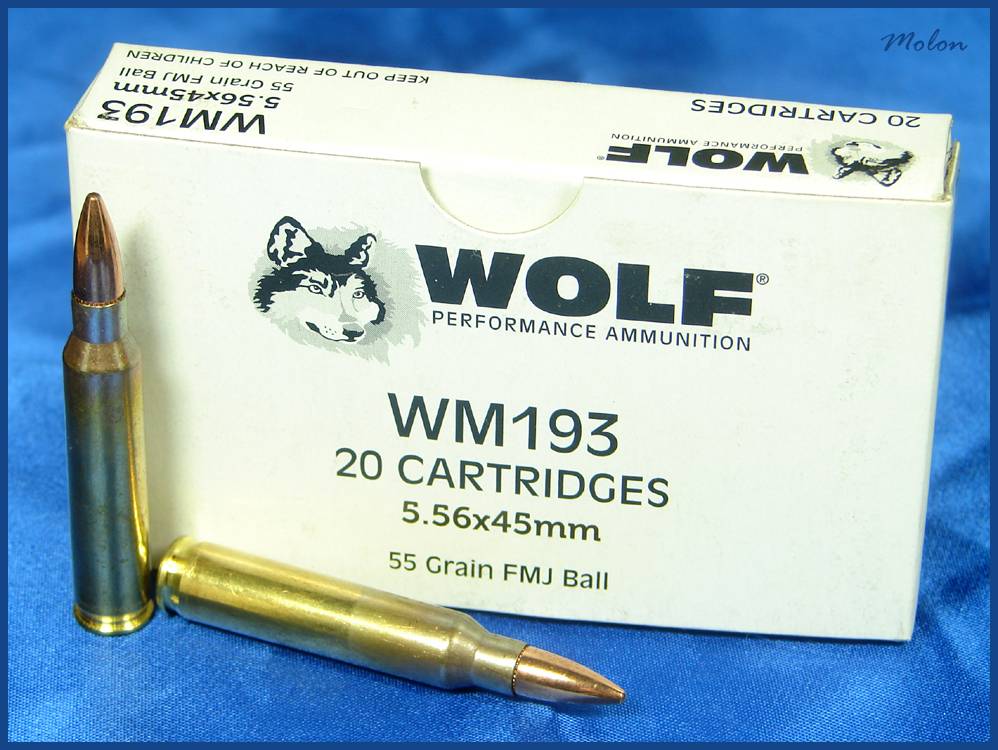 Notice that the box in the above picture is white. Also notice that the word “gold” does not appear anywhere on that box. Just, sayin’. It is known by many that Wolf does not manufacture ammunition, but rather, is an importer of ammunition. Wolf WM193 is imported from Taiwan. Unlike the steel-cased, bi-metal jacketed Wolf Performance Ammunition that is imported from Russia, Wolf WM193 has copper jacketed bullets loaded in brass cases. On-line vendors selling this ammunition claim that it is “manufactured to M193 specs.” Genuine US Military M193 can no longer be sold to civilians, thanks to the Clinton Administration. The ammunition that is sold on the commercial market with some form of “M193” in its nomenclature is often referred to as an “M193 clone” because it “appears to be a copy” of genuine M193, but we generally have no idea what specifications of MIL-C-9963 that this ammunition has passed, or has even been tested for. Genuine M193 must be tested for and pass all of the specifications laid out in the mil-spec, MIL-C-9963. The required areas of testing included in MIL-C-9963 range from velocity, accuracy, chamber pressure and port pressure to waterproofing, temperature stability, bullet extraction, case hardness, fouling and much more. M193 is loaded with a 55 grain FMJ bullet with a cannelure. The bullet itself, must meet required specifications in order to be used in genuine M193 ammunition. For example, the specification for the thickness of the gilding metal jacket of the bullet is 0.021" with a tolerance of - 0.002". For comparison, the jacket of Hornady’s 55 grain FMJ bullet has a thickness of approximately 0.028”. Jacket thickness can have a significant effect on terminal ballistic properties, particularly that of fragmentation. Even the composition of the copper alloy used for the jacket and the lead used for the slug must meet mil-spec requirements for genuine M193. Genuine M193 can only be charged with powder that has been specifically approved by the US Military for use in this cartridge. If the ammunition in question is not loaded with one of the approved powders, it is not genuine M193 and naturally we have no way of determining what powder was used in a load simply by visual inspection. Genuine M193 will have the annealing iris visible on the shoulder and neck portion of the case. It will also will have crimped and sealed primers. Genuine M193 has a crimped case mouth along with sealant at the case mouth. 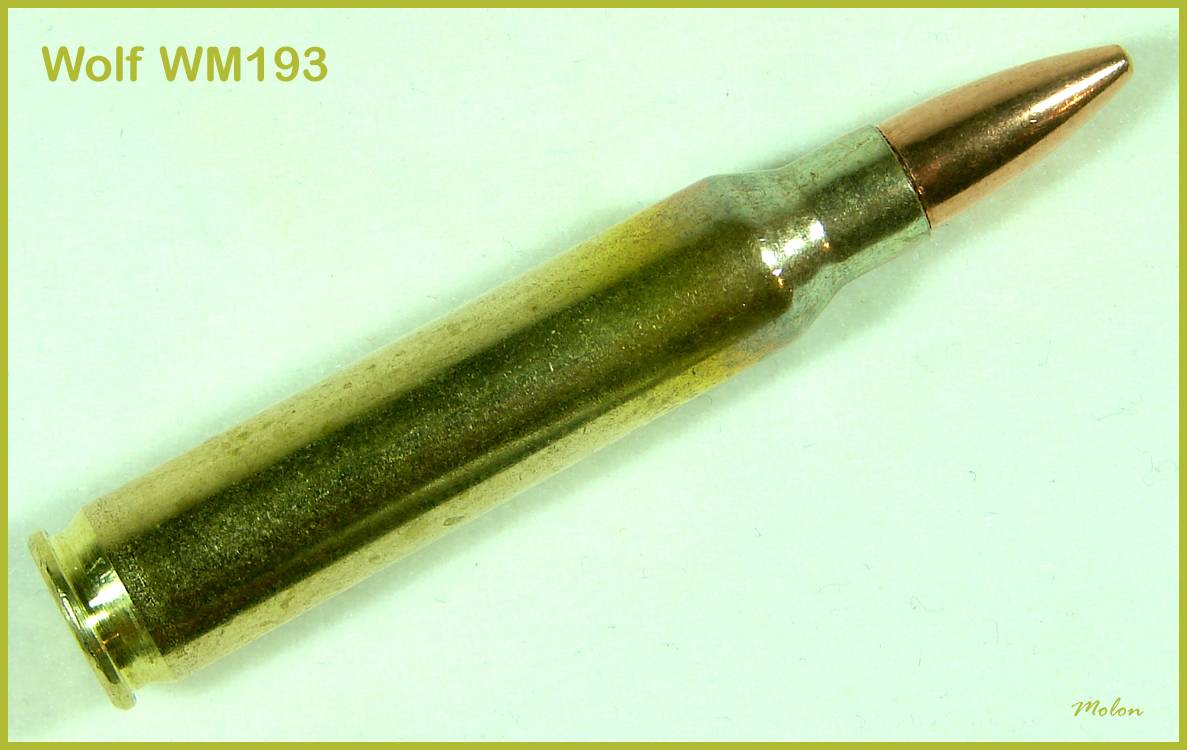 The annealing iris is lightly visible on the WM193 brass cases, though it’s not nearly as distinct as on a Lake City case. 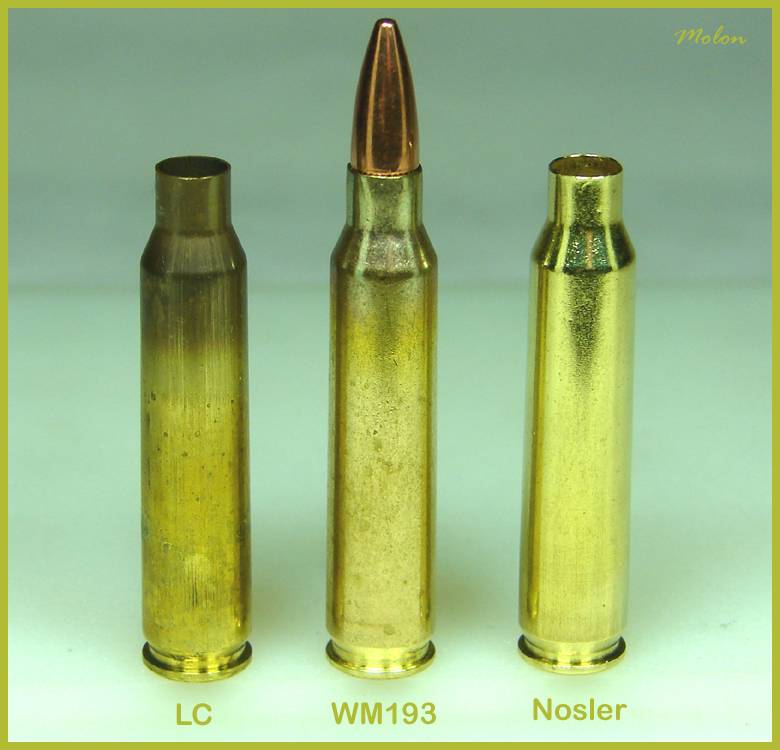 The Wolf WM193 uses a typically shaped 55 FMJ projectile with a cannelure and has a nominal length of 0.743”. The case mouth has a collet-crimp and asphalt sealant. 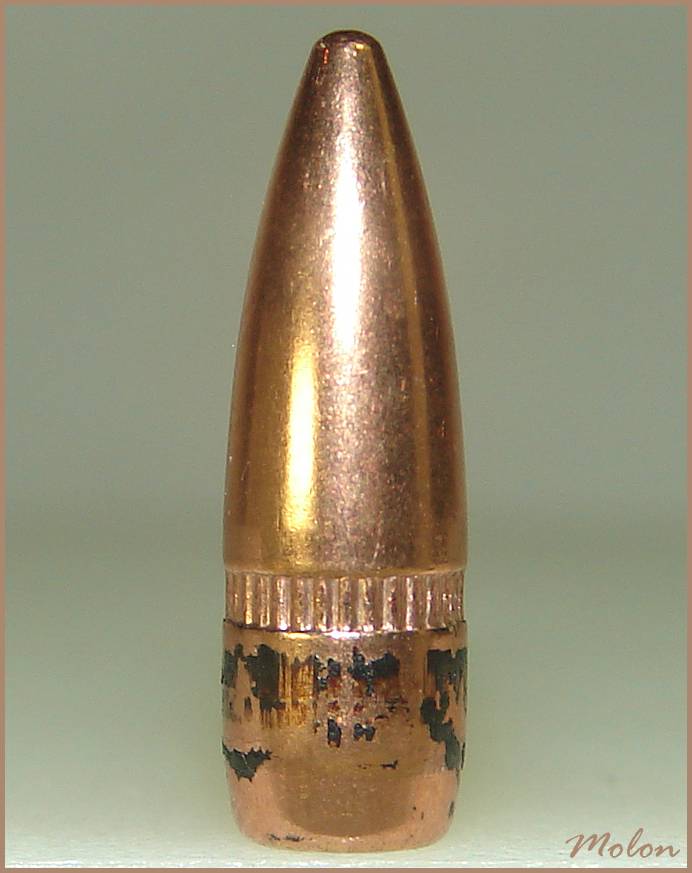 The head-stamp for this ammunition reads: “556 Wolf”. The primer pockets are crimped and smeared with sealant. 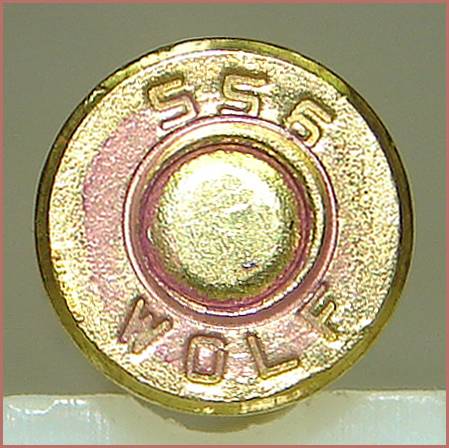 As with most M193 clones, the WM193 is charged with a flattened “ball” powder. 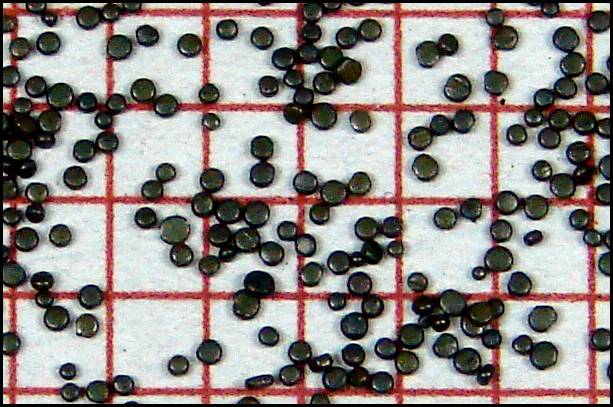 Velocity Aside from aspects of M193 clones that can be assessed by visual inspection, the two main aspects of M193 clones that we can assess via live fire testing to determine if an M193 clone adheres to the US mil-spec are velocity and accuracy (technically precision). The velocity specification for M193 as cited in MIL-C-9963F states: The average velocity of the sample cartridges, conditioned at 72 degrees, plus or minus 2 degrees Fahrenheit (F), shall be 3165 feet per second (ft/sec), plus or minus 40 ft/sec, at 78 feet from the muzzle of the weapon. The standard deviation of the velocities shall not exceed 40 ft/sec. The specification is for a 20” barrel. Depending on multiple variables, this velocity specification equates to a muzzle velocity of approximately 3270 FPS, plus or minus 40 FPS. I chronographed the Wolf WM193 ammunition from a semi-automatic AR-15 with a chrome-lined, NATO chambered 20” Colt barrel.  As an aside, after reading the above specification, some of you may be wondering, “Why 78 feet from the muzzle?” The answer to that question is that this specification is simply an historical hold-over from the days when “circuit” chronographs (e.g. Le Boulenge Chronograph and the Aberdeen Chronograph) were used at Aberdeen Proving Ground, Frankford Arsenal and Springfield Armory. These types of chronographs required a significant distance between their first and second screens to produce accurate results. As an example, when using the Boulenge Chronograph, the first screen of the chronograph was placed 3 feet in front of the muzzle and the second screen was placed 150 feet beyond the first screen. For those of you who might not be aware of the following fact; chronographs determine the velocity of the bullet at a point that is midway between the first and the second screen (i.e. not at the location of the first screen). Therefore, with the above spacing, the velocity of the bullet is determined for a point that is 75 feet from the first screen. So, add the three feet (from the muzzle to the first screen) to the 75 feet (the midway point of the screens) to obtain the “78 feet from the muzzle” distance.  Chronographing was conducted using an Oehler 35-P chronograph with “proof screen” technology. The Oehler 35P chronograph is actually two chronographs in one package that takes two separate chronograph readings for each shot and flags any errant readings to let you know that the data is suspect. There was no invalid data flagged during this testing. The velocity stated below is the muzzle velocity as calculated from the instrumental velocity using Oehler’s Ballistic Explorer software program. The string of fire consisted of 10 rounds over the chronograph. 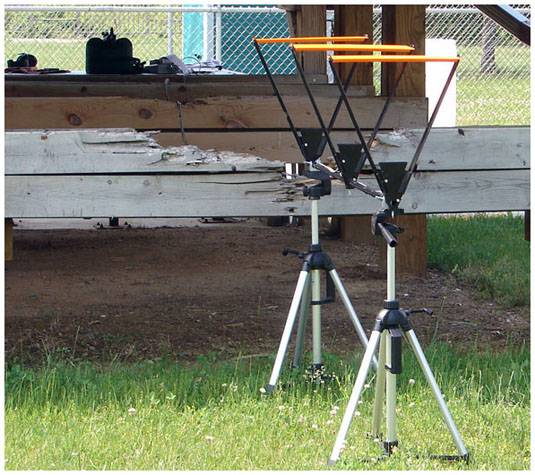  Each round was single-loaded and cycled into the chamber from a magazine fitted with a single-load follower. The bolt locked-back after each shot allowing the chamber to cool in between each shot. This technique was used to mitigate the possible influence of “chamber-soak” on velocity data. Each new shot was fired in a consistent manner after hitting the bolt release. Atmospheric conditions were monitored and recorded using a Kestrel 4000 Pocket Weather Tracker.  Atmospheric conditions. Temperature: 71.6 degrees F Humidity: 78.4% Barometric pressure: 30.02 inches of Hg Elevation: 950 feet above sea level The average muzzle velocity for the 10-shot string of the Wolf WM193 ammunition fired from the 20” Colt barrel was 3088 FPS with a standard deviation of 16 FPS. The coefficient of variation was 0.52%. For comparison, legacy IMI M193 had a muzzle velocity of 3274 FPS when fired from a 20” Colt barrel with a standard deviation of 18 FPS and coefficient of variation of 0.55%. For those of you who might not be familiar with the coefficient of variation (CV), it is the standard deviation, divided by the mean (average) muzzle velocity and then multiplied by 100 and expressed as a percentage. It allows for the comparison of the uniformity of velocity between loads in different velocity spectrums; e.g. 77 grain loads averaging approximately 2,650 fps compared to 55 grain loads averaging approximately 3,250 fps. The US mil-spec for M193 allows for a coefficient of variation of approximately 1.2%, while one of my best 77 grain OTM hand-loads, with a muzzle velocity of 2639 PFS and a standard deviation of 4 FPS, has a coefficient of variation of 0.15%.  Accuracy The US accuracy specification for M193 cited in MIL-C-9963F is as follows: “The average of the mean radii of all targets of the sample cartridges, fired at 200 yards, shall not exceed 2.0 inches.” These averages are from 10-shot groups fired from machine rested, bolt-actioned, heavy test barrels. All things being equal this specification equates to a mean radius of 1 inch at 100 yards (the distance at which I tested this ammunition). I conducted an accuracy (technically, precision) evaluation of the Wolf WM193 following my usual protocol. This accuracy evaluation used statistically significant shot-group sizes and every single shot in a fired group was included in the measurements. There was absolutely no use of any Group Reduction Techniques (e.g. fliers, target movement, Butterfly Shots). The shooting set-up will be described in detail below. As many of the significant variables as was practicable were controlled for. Also, a control group was fired from the test-rifle used in the evaluation using match-grade, hand-loaded ammunition; in order to demonstrate the capability of the barrel. Pictures of shot-groups are posted for documentation. All shooting was conducted from a concrete bench-rest from a distance of 100 yards (confirmed with a laser rangefinder.) The barrel used in the evaluation was free-floated. The free-float handguards of the rifle rested in a Sinclair Windage Benchrest, while the stock of the rifle rested in a Protektor bunny-ear rear bag. Sighting was accomplished via a Leupold VARI-X III set at 25X magnification and adjusted to be parallax-free at 100 yards. A mirage shade was used. Wind conditions on the shooting range were continuously monitored using a Wind Probe. The set-up was very similar to that pictured below. 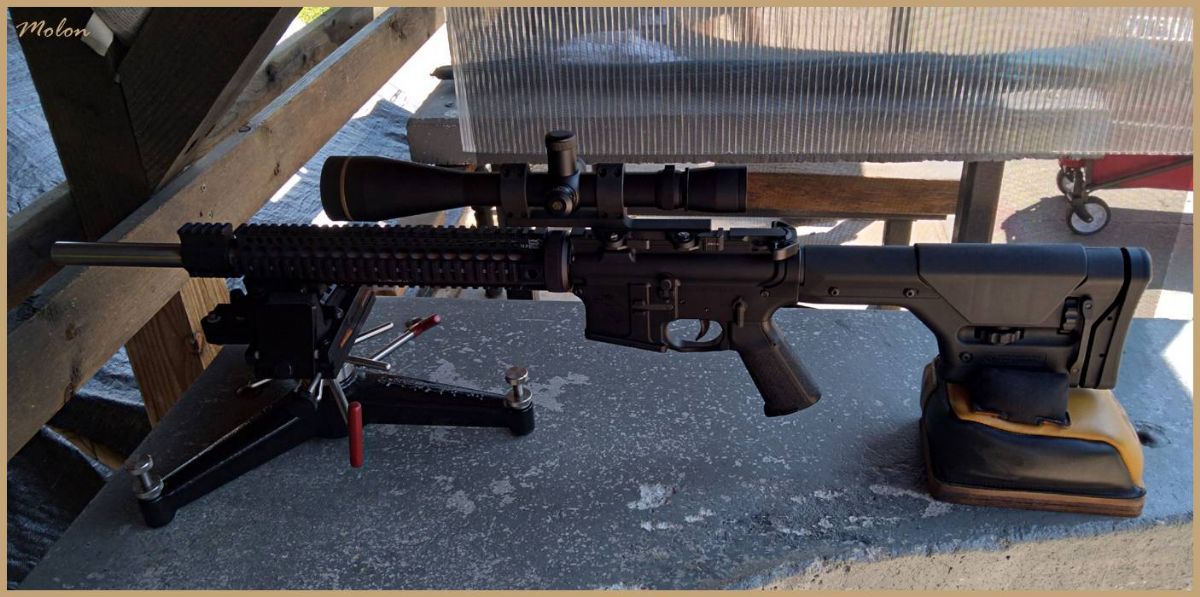 The Wind Probe . . . 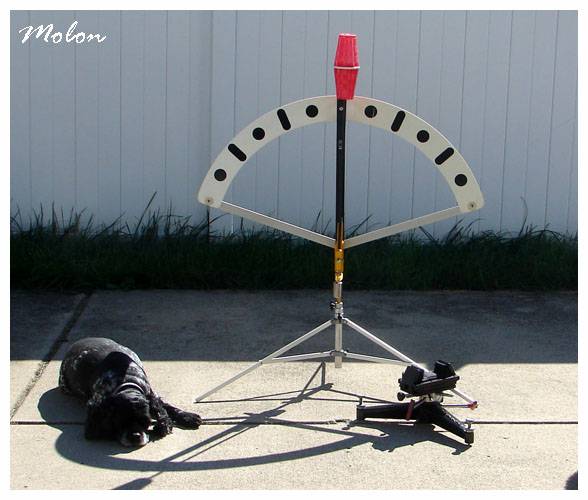 The test vehicle for this evaluation was one of my semi-automatic precision AR-15s with a 20” stainless-steel Lothar Walther barrel. The barrel has a 223 Wylde chamber with a 1:8” twist. 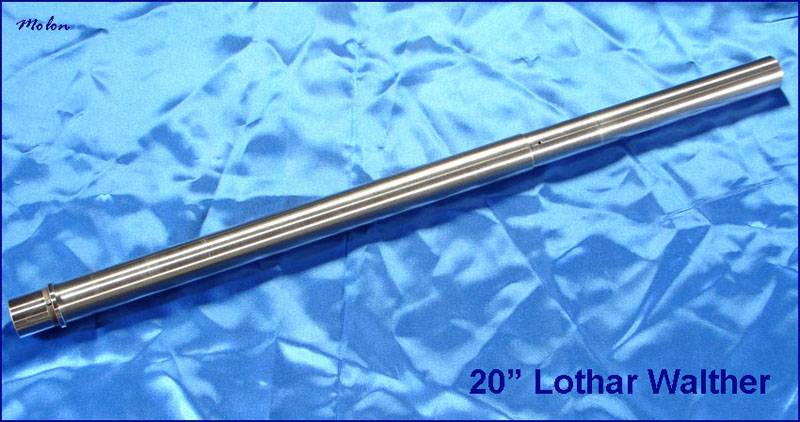 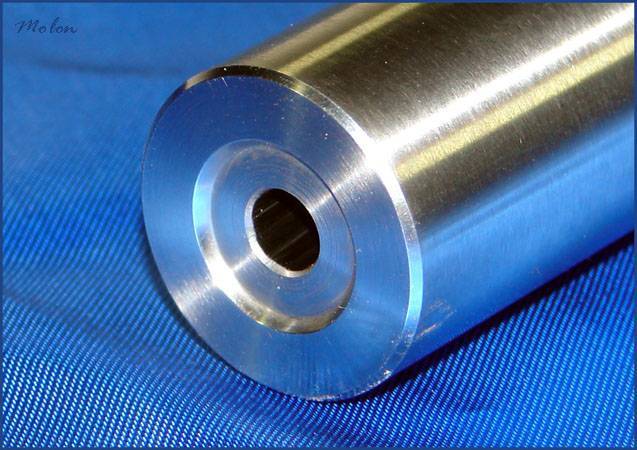 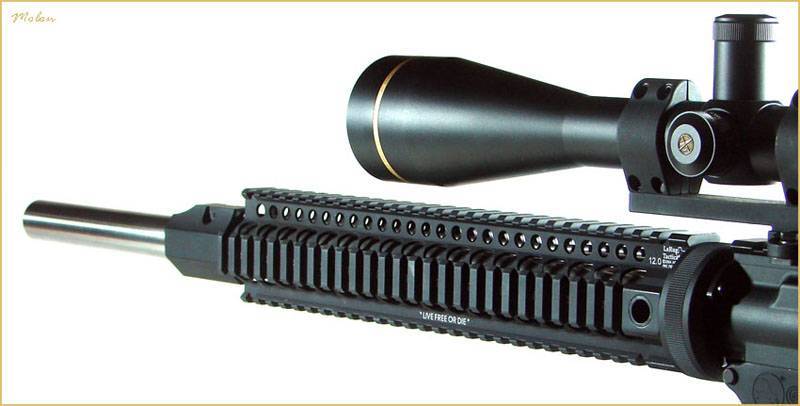 Prior to firing the Wolf WM193, I fired a 10-shot control group using match-grade hand-loads topped with the Sierra 52 grain MatchKing. That group had an extreme spread of 0.62”. 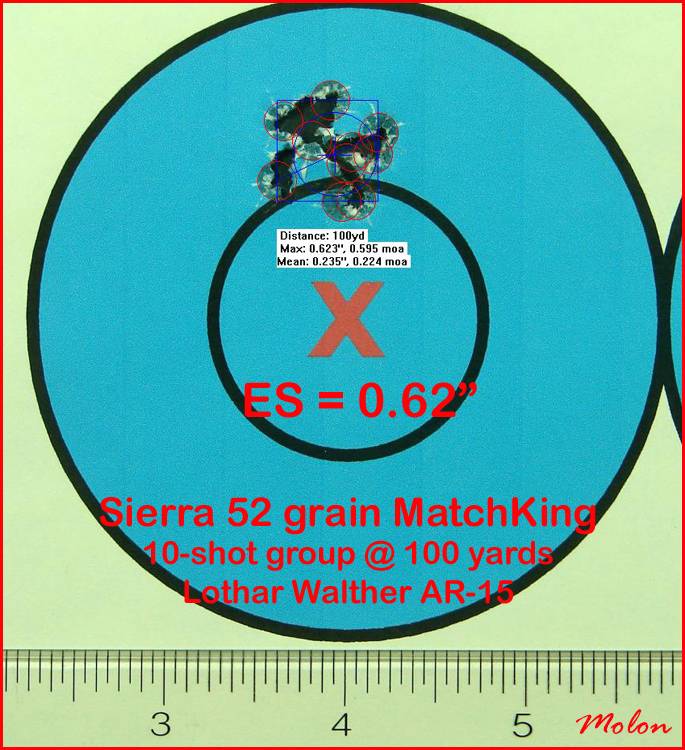 Three 10-shot groups of the Wolf WM193 ammunition fired consecutively from the Lothar Walther barreled AR-15 at a distance of 100 yards had the following extreme spreads: 1.72” 1.63” 1.62” for a 10-shot group average extreme spread of 1.66”. I over-layed the three 10-shot groups on each other using RSI Shooting Lab to form a 30-shot composite group. The mean radius of the 30-shot composite group was 0.60”. The smallest 10-shot group . . . 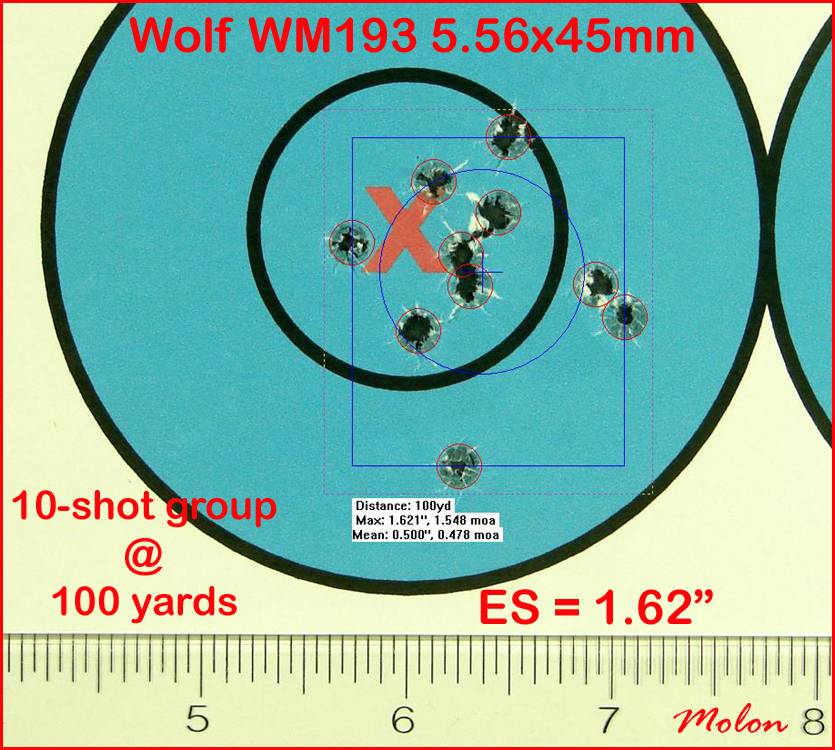 The 30-shot composite group . . . 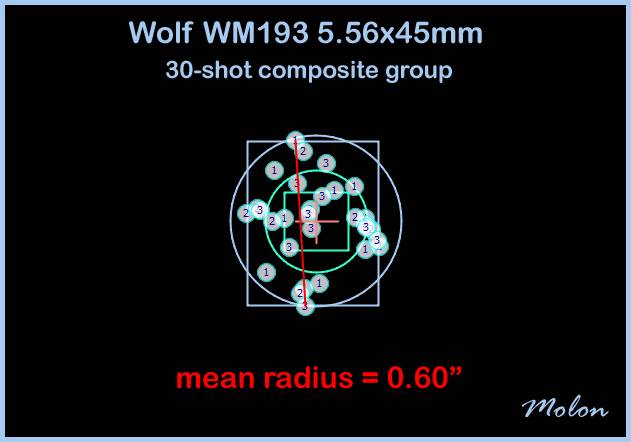 For comparison, you can view my evaluation of the Wolf Gold 55 grain FMJ 223 Remington ammunition https://www.ar15.com/forums/AR-15/Wolf-Gold-55-grain-FMJ-Accuracy-and-Velocity/16-687936/?page=1 The results of both evaluations are summarized in the tables below. 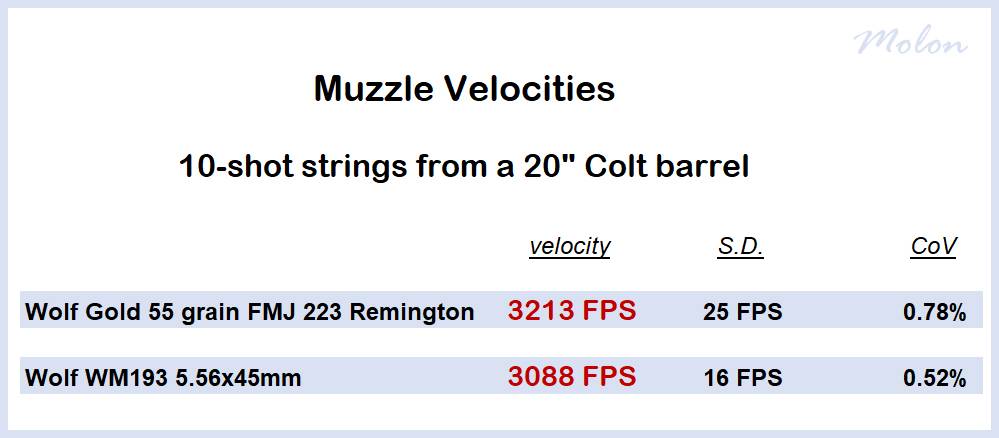 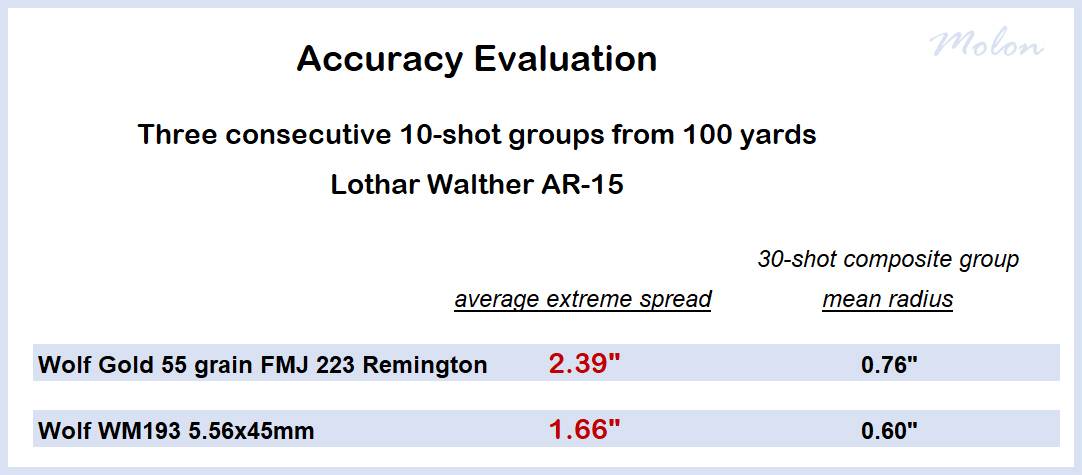 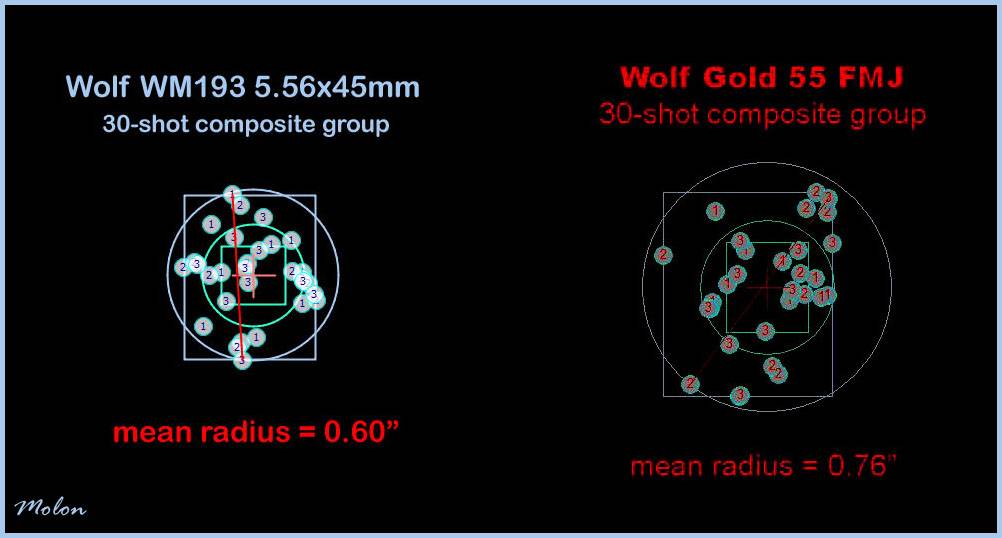  …. |
|
|
All that is necessary for Trolls to flourish, is for good men to do nothing.
In God We Trust. Everyone else must post data. |
 Win a FREE Membership!
Win a FREE Membership!
Sign up for the ARFCOM weekly newsletter and be entered to win a free ARFCOM membership. One new winner* is announced every week!
You will receive an email every Friday morning featuring the latest chatter from the hottest topics, breaking news surrounding legislation, as well as exclusive deals only available to ARFCOM email subscribers.
AR15.COM is the world's largest firearm community and is a gathering place for firearm enthusiasts of all types.
From hunters and military members, to competition shooters and general firearm enthusiasts, we welcome anyone who values and respects the way of the firearm.
Subscribe to our monthly Newsletter to receive firearm news, product discounts from your favorite Industry Partners, and more.
Copyright © 1996-2024 AR15.COM LLC. All Rights Reserved.
Any use of this content without express written consent is prohibited.
AR15.Com reserves the right to overwrite or replace any affiliate, commercial, or monetizable links, posted by users, with our own.

